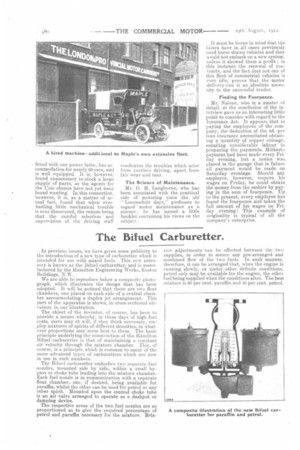The Bifuel Carburetter.
Page 16

If you've noticed an error in this article please click here to report it so we can fix it.
In previous issues, we have given some publicity to the introduction of a new type of carburetter which is intended for use with mixed fuels. This new accessory is known as the Bifuel carburetter, and is manufactured by the Hamilton Engineering Works, Euston Buildings, N.W.
We are able to reproduce below a composite photograph, which illustrates the design that has been adopted. It will be noticed that there are two float chambers, one placed on each side of a central chamber accommodating a duplex jet arrangement. This part of the apparatus is shown, in cross-sectional elevation, in our illustration.
The object of the inventor, of course, has been to provide a means whereby, in these days of high fuel costs, users may at will, if they think necessary, employ mixtures of spirits of different densities, in whatever proportions may seem best to them. The basic principle underlying the construction of the Hamilton Bifuel carburetter is that of maintaining a constant air velocity through the mixture chamber. This, of course, is a principle which is common to many of the more advanced types of carburetters which are now in use in such numbers.
The Bifuel carburetter embodies two separate fuel nozzles, mounted side by side, within a small bypass or choke tube leading into the mixture chamber. Each fuel nozzle is in communication with a separate float chamber, one, if desired, being available for paraffin, whilst the other can be used for petrol or any other spirit. Mounted upon the central choke tube is an air valve arranged to operate as a ciashpot or damping device.
The respective areas of the two fuel nozzles are so proportioned as to give the required percentage of petrol and paraffin necessary for the mixture. Rela Live adjustments can be effected between the two supplies, in order to secure any pre-arranged and eombined flaw of the two fuels. In such manner, therefore, it can be arranged that, when the engine is running slowly, or under other definite conditions, petrol only may be available for the engine, the other fuel being supplied when the conditions alter. The best mixture is fi0 per cent. paraffin and 40 per cent, petrol.






















